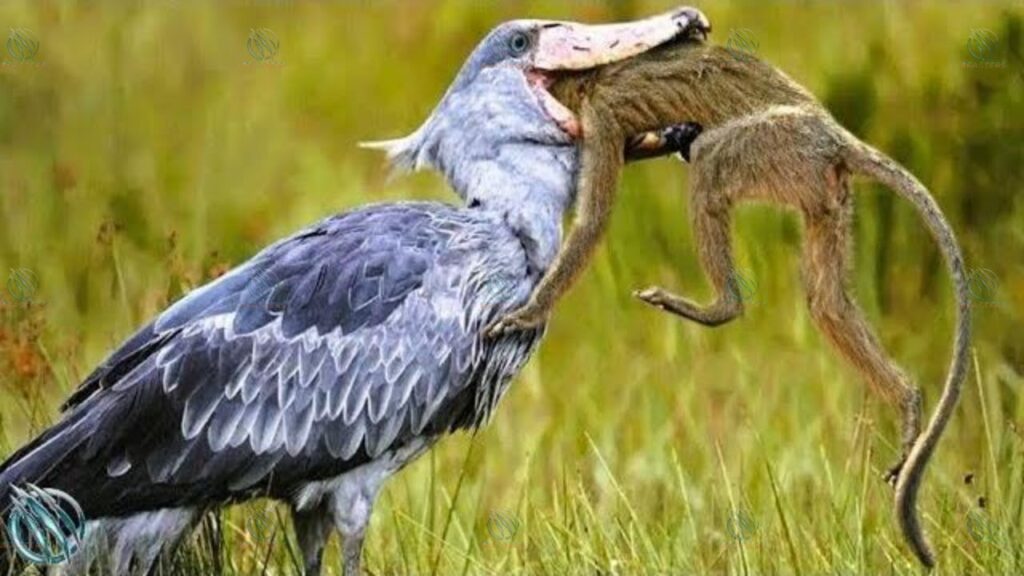The shoebill (Balaeniceps rex), also known as the whalehead, is a large, distinctive bird native to the swamps and wetlands of central tropical Africa.
Renowned for its prehistoric appearance and exceptional hunting skills, the shoebill is a fascinating subject for ornithologists and bird enthusiasts alike.
This article delves into the intriguing world of the shoebill, exploring its unique characteristics, habitat, and predatory tactics that make it the undisputed king of African wetlands.
1. The Unmistakable Appearance of the Shoebill
The shoebill is instantly recognizable due to its unique appearance.
Standing up to 5 feet tall with a wingspan of over 8 feet, it has a commanding presence.
Its most distinctive feature is its large, shoe-shaped bill, which is about 9 inches long and 4 inches wide.
This bill is perfectly adapted for catching and holding slippery prey.
The shoebill’s plumage is predominantly grey, providing excellent camouflage in its wetland habitat.
Its piercing yellow eyes and broad, powerful neck add to its intimidating look, making it one of the most striking birds in the avian world.
2. Habitat: The Shoebill’s Wetland Kingdom
Shoebills inhabit the vast wetlands and swamps of central tropical Africa, including countries like Uganda, Sudan, and Zambia.
They prefer areas with dense vegetation, which offer plenty of hiding spots and abundant prey.
These wetlands are rich in fish, amphibians, and reptiles, providing the perfect hunting ground for the shoebill.
The bird’s ability to stand motionless for hours makes it a master of stealth, allowing it to blend seamlessly into its environment while waiting for the perfect moment to strike.
3. Stealth and Patience: The Shoebill’s Hunting Strategy
One of the most remarkable aspects of the shoebill is its hunting technique.
Unlike many other birds that rely on speed and agility, the shoebill uses stealth and patience. It can stand still for hours, waiting for its prey to come within striking distance.
This tactic is particularly effective in the dense vegetation of its wetland habitat, where sudden movements would easily alert potential prey.
Once the shoebill spots a target, it strikes with lightning speed, using its powerful bill to capture and crush its prey.
4. The Powerful Shoebill Bill: A Perfect Hunting Tool

The shoebill’s bill is not only large but also incredibly powerful.
It has sharp edges and a hooked tip, which it uses to catch and hold onto slippery prey such as fish and frogs.
The bill’s size allows the shoebill to capture large prey items that other birds would struggle with.
Additionally, the bill is equipped with sharp, hook-like structures called tomial teeth, which help the shoebill to secure its catch firmly.
This adaptation is essential for hunting in the wetland environment, where prey can easily escape if not held securely.
5. Diet: A Carnivorous Connoisseur
Shoebills are primarily carnivorous, with a diet that consists mainly of fish, such as lungfish, tilapia, and catfish.
They are also known to eat amphibians, reptiles, and occasionally small mammals and birds.
Their preference for large prey items sets them apart from other wetland birds, which typically feed on smaller fish and invertebrates.
This diet requires the shoebill to be an expert hunter, capable of capturing and consuming a wide variety of prey.
6. Ambush Hunting: The Element of Surprise
The shoebill’s hunting success is largely due to its ambush strategy.
By remaining motionless and blending into the vegetation, the shoebill can take its prey by surprise.
This method is particularly effective in the dense, murky waters of the wetlands, where visibility is low, and prey is often unaware of the lurking predator.
When the shoebill strikes, it does so with incredible speed and precision, giving its prey little chance to escape.
7. The Art of Balancing: Shoebill’s Hunting Posture
A unique aspect of the shoebill’s hunting technique is its posture.
The bird stands still, often balancing on one leg, to reduce its profile and minimize disturbances in the water.
This balance allows the shoebill to maintain its position for extended periods, making it an efficient ambush predator.
The ability to stand still for hours is a testament to the shoebill’s patience and dedication to its hunting craft.
8. The Role of Sight and Sound in Hunting

Shoebills rely heavily on their keen eyesight and acute hearing to detect prey.
Their large eyes provide excellent vision, allowing them to spot even the slightest movements in the water.
Additionally, their ability to hear the sounds of potential prey helps them to locate hidden fish and amphibians.
This combination of sight and sound makes the shoebill an incredibly effective predator, able to hunt successfully in the challenging wetland environment.
9. The Importance of Water Management
Water management is crucial for the shoebill’s hunting success.
The bird often hunts in shallow water, where it can wade through the vegetation without making too much noise.
By carefully choosing hunting spots with the right water depth and vegetation cover, the shoebill maximizes its chances of capturing prey.
This strategic use of its environment is another reason why the shoebill is such a successful hunter.
10. The Shoebill’s Role in the Ecosystem
The shoebill plays a vital role in its ecosystem by controlling the population of fish and amphibians in the wetlands.
As an apex predator, it helps to maintain a balance in the food chain, ensuring that no single species dominates the habitat.
This balance is essential for the health and diversity of the wetland ecosystem, making the shoebill a keystone species in its environment.
Other Stories You May Like
Conclusion: The Majestic Shoebill and Its Future
The shoebill stands as a testament to the incredible diversity and adaptability of life in the African wetlands.
Its unique appearance, fascinating behavior, and exceptional hunting skills make it a true king of its environment.
However, the shoebill’s future is uncertain due to the ongoing threats of habitat loss and human activity.
It is crucial to continue and expand conservation efforts to protect this extraordinary bird and ensure that it remains a symbol of the wild, untamed beauty of Africa’s wetlands for generations to come.
By understanding and appreciating the shoebill’s role in the ecosystem and its remarkable predatory tactics, we can foster a greater sense of responsibility towards preserving its habitat and ensuring its survival.
The shoebill’s story is not just one of a remarkable bird but also a reminder of the delicate balance of nature and our role in protecting it.





















